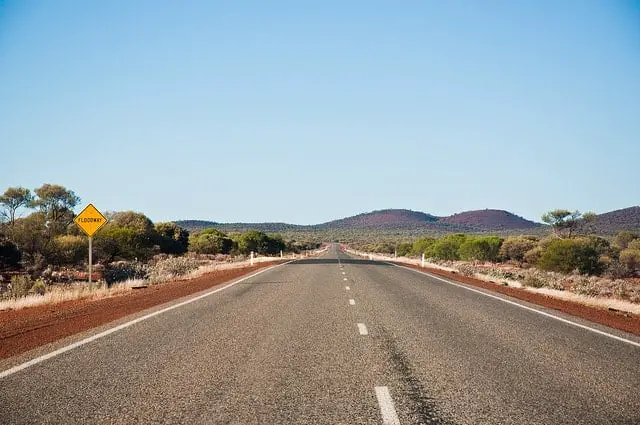Posted in: Blog
Western Australia (WA) is the largest state in Australia, occupying one-third of the continent with a total land size of 2.5million square kilometers. With a population of 2.4 million people at the last census (that’s less than one person per square kilometer of land), and the bulk of people living in the south-west corner, all of that basically translates to a lot of vast uninhabited areas dotted with small towns.

What does that mean for the digital nomad?
With towns few and far between, and large distances to cover with telecommunications infrastructure, Western Australia is arguably the most challenging places to work as digital nomad in Australia.
Australia isn’t the easiest country to be a digital nomad in in the first place. In comparison to most other first world nations, Australia’s telecommuncation and Internet speeds are low, while data and phone plans are expensive for what you get.
It all comes down to one major issue – a huge landmass with a small population and harsh conditions, making infrastructure expensive and widely spaced. We are talking about a country roughly the same size as the United States with only 7% of the population. In Western Australia the problem is magnified even further because the population is so small and the distances (and conditions) are so extreme.
In Western Australia, telephone and Internet coverage is often limited to towns, and even then it can be slow. You’ll often find it is limited to the centre of town, or at least no more than 10 kilometers outside of town. Inside towns expect the occasional blackspot where you won’t get any coverage. Even in Perth phone coverage can be hit and miss depending on your location!
You can certainly travel around Western Australia while you work, but you will probably spend a lot of your actual work time feeling rather frustrated and challenged.
Don’t let that deter you from booking flights to Perth – Western Australia is worth the challenge. You just need to have a plan for how you are going to get online to do your work, and be ready to for the frustrations! Once you are able to get online in Perth (It may be difficult, but it’s not impossible!), you should spend the first few minutes trying to book a hotel in the area. It’s easy to book a hotel in Perth with Expedia. The process is very fast, and the website allows you to search for exactly what you want without having to sift through a whole mess of rooms you’re not the least bit interested in. Even if you’re only able to stay connected to the internet for a few minutes (which may happen), you’ll still be able to reserve that room with Expedia.
Get a mobile data plan
Telstra’s Next G network offers the best coverage. The network isn’t comprehensive but it’s your best option unless you have the money to pay for a satellite phone! Take a look at this state coverage map generated by Telstra to get a better picture.
You have two real options – get a mobile phone with a data plan that you can share with your laptop or tablet, or get a mobile prepaid plan that makes use of a USB modem/dongle. For a plan with 3-5Gig of data at a decent connection speed you will have to spend $99-130 per month. It’s a lot of money but Telstra are the only ones that offer even reasonable coverage so if you don’t want to be reliant on internet cafes and your accommodation having WIFI, it really is your best option.
Of course it’s worth mentioning that the connection speeds you see on the Telstra website are for ideal conditions that’s you’ll generally only get in capital cities on the east coast. Internet speeds in Western Australia, even in Perth and other major towns will be slower than this.
Boost your signal
If you are driving your way around Western Australia, it is worth looking into buying an antenna and even a booster to amplify your mobile signal. In most towns that have mobile network coverage, the signal dies out once you are 10km from town. An antenna and booster will allow you to get signal much further away … provided there are no hills in between!
We’re not going to give you advice on what’s the best option to get – the technology is constantly changing and it really depends on how you are travelling around, and in what! Check out what the locals are using and ask around at stores in Perth.
Make the most of Telecentres
Telecentre’s are a place where the public can access and use telecommunications. Telecentres provide rural communities with fast broadband accesss to the Internet, computers, photocopiers, facsimile machines, modems, printers, scanners and videoconferencing facilities. They’re also often linked to local post offices, government services and offer computer skills training programs.
Western Australia has roughly 100 telecentres. Actually they’ve recently been renamed to Community Resource Centres but almost everyone knows them as telecentres so lets call them that.
They’re independently managed so you can’t buy a state wide membership. However membership for anything from three months to a year to an individual centre is usually between $8-20.
A friend, Amy Page, from Living On The Road, has been travelling and working remotely around Western Australia for the past six months. When I spoke to her about her experiences in Western Australia, one of her biggest recommendations was making use of telecentres. She paid $8 for a three month membership which provided her with two hours per day of unlimited access to broadband Internet, with extra hours charged at $3 per hour. Telecentres allow you to take your own laptop in and use their Internet, which was perfect for her needs however many don’t allow you to charge your laptop while there.
Make use of public libraries and Internet Cafes
Western Australia has 223 public libraries, most of which have Internet facilities. For a list of public library’s visit the State Library of Western Australia.
In most mid-sized towns you’ll also find Internet cafes. The problem is some cafes like to charge extra to use your own laptop rather than their computers. On the plus side, most cafe’s will require that you connect through a cable so even if they don’t have a power point you can use, your battery will last a lot longer since you won’t be needing to use WIFI. This means you can work longer and get the most out of your money!
Base yourself in larger towns and take short excursions
Even with Telstra Next G and something to boost your signal, you will find that in remote areas Internet and phone reception is either non-existent or frustratingly slow.
So it’s not a bad idea for the digital nomad to base themselves in larger population areas and take shorter trips into remote areas than just travel around. Perth, Albany, Port Headland, Broome, Geralton, Exmouth, Fremantle and most of the mining towns all have better mobile coverage than smaller towns.
If being online frequently is important to your business, then plan your travels in Western Australia around being based in larger towns. Take weekend or longer trips into rural areas when your workload is less and you can get away with just keeping an eye on emails and being contactable when (if!) you have coverage, then come back as soon as you need to access reliable Internet again. If you are basing yourself somewhere it also gives you the option of trying to find a short term rental in an apartment that has broadband already connected.
A big thank you goes out to Amy Page for her advice and contributions to this article. If all of this has scared you off visiting Western Australia, be sure to visit her site Livin On The Road to check out their amazing photos of this region of Australia and be reassured that Western Australia is worth the challenges!


WA is absolutely gorgeous, but not very wifi friendly at all. Starting our travels i was shocked to see how fast the internet could be… Only 5 hours across the waters in KL. haha. In saying that we had a plan that cost us $89 per month for a speed of roughly 4MB, however we had over 100Gb of bandwidth & it included VOIP, etc. it was a great plan, but for what we pay in Asia now I am shocked haha.
Good advice, thanks for sharing. It’s funny how much we take wifi and internet access for granted these days. I’ve run into access problems in countries like Ghana and Ecuador but wouldn’t have thought a country like Australia would face similar challenges.
http://goo.gl/lmzNG
How do I find a good traveling job, something that I can help others and see the things that are blind to most human eye’s. I wanna travel the world and do a little of everything?
Aren’t mobile phone boosters illegal in Australia?